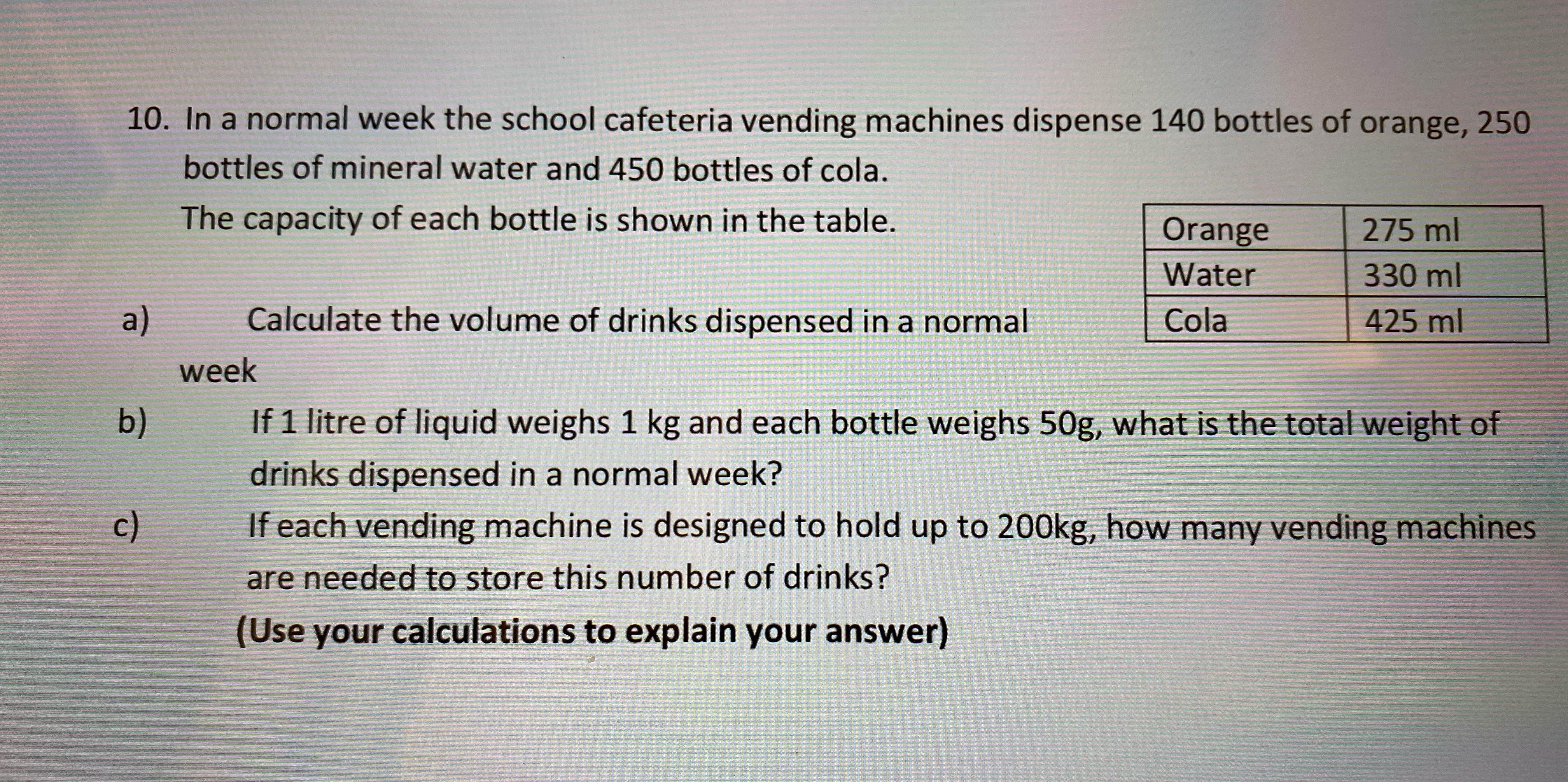In a normal week the school cafeteria vending machines dispense 140 bottles of orange, 250 bottles of mineral water and 450 bottles of cola. The capacity of each bottle is shown in... In a normal week the school cafeteria vending machines dispense 140 bottles of orange, 250 bottles of mineral water and 450 bottles of cola. The capacity of each bottle is shown in the table. a) Calculate the volume of drinks dispensed in a normal week. b) If 1 litre of liquid weighs 1 kg and each bottle weighs 50g, what is the total weight of drinks dispensed in a normal week? c) If each vending machine is designed to hold up to 200kg, how many vending machines are needed to store this number of drinks?

Understand the Problem
The question describes the number of bottles of different drinks (orange, water, and cola) dispensed by vending machines in a school cafeteria during a normal week. The capacity of each bottle type is provided. There are three parts to the question: (a) to calculate the total volume of drinks dispensed in a normal week, (b) calculate the total weight of the dispensed drinks given that 1 liter of liquid weighs 1 kg and each bottle weighs 50g, and (c) determine how many vending machines are needed to store all the drinks if each vending machine can hold up to 200kg. We need to use the provided quantities and capacities to compute the volume and weight, and then determine the number of vending machines required.
Answer
a) $312.25$ liters b) $354.25$ kg c) $2$
Answer for screen readers
a) The total volume of drinks is $312.25$ liters. b) The total weight of drinks dispensed is $354.25$ kg. c) $2$ vending machines are needed.
Steps to Solve
- Calculate the total volume of orange drink
Multiply the number of orange bottles by the volume of each bottle.
$140 \text{ bottles} \times 275 \text{ ml/bottle} = 38500 \text{ ml}$
Convert ml to liters by dividing by 1000.
$38500 \text{ ml} \div 1000 = 38.5 \text{ liters}$
- Calculate the total volume of water
Multiply the number of water bottles by the volume of each bottle.
$250 \text{ bottles} \times 330 \text{ ml/bottle} = 82500 \text{ ml}$
Convert ml to liters by dividing by 1000.
$82500 \text{ ml} \div 1000 = 82.5 \text{ liters}$
- Calculate the total volume of cola
Multiply the number of cola bottles by the volume of each bottle.
$450 \text{ bottles} \times 425 \text{ ml/bottle} = 191250 \text{ ml}$
Convert ml to liters by dividing by 1000.
$191250 \text{ ml} \div 1000 = 191.25 \text{ liters}$
- Calculate the total volume of all drinks
Add the volume of orange, water, and cola.
$38.5 + 82.5 + 191.25 = 312.25 \text{ liters}$
- Calculate the total weight of the liquid
Since 1 liter of liquid weighs 1 kg, the total weight of the liquid is equal to the total volume in liters.
$312.25 \text{ liters} \times 1 \text{ kg/liter} = 312.25 \text{ kg}$
- Calculate the total weight of the bottles
Calculate the total number of bottles.
$140 + 250 + 450 = 840 \text{ bottles}$
Since each bottle weighs 50g, the total weight is:
$840 \text{ bottles} \times 50 \text{ g/bottle} = 42000 \text{ g}$
Convert grams to kilograms by dividing by 1000
$42000 \text{ g} \div 1000 = 42 \text{ kg}$
- Calculate the total weight of the drinks and bottles
Add the weight of the liquid and the weight of the bottles.
$312.25 + 42 = 354.25 \text{ kg}$
- Calculate the number of vending machines needed
Divide the total weight by the capacity of each vending machine.
$\frac{354.25}{200} = 1.77125$
Since you can't have a fraction of a vending machine, round up to the nearest whole number.
$2 \text{ vending machines}$
a) The total volume of drinks is $312.25$ liters. b) The total weight of drinks dispensed is $354.25$ kg. c) $2$ vending machines are needed.
More Information
The calculations assume that the volumes given are exact. In a real-world scenario, there might be slight variations.
Tips
- Forgetting to convert milliliters to liters or grams to kilograms.
- Not including the weight of the bottles in the total weight calculation.
- Not rounding up to the nearest whole number when calculating the number of vending machines.
AI-generated content may contain errors. Please verify critical information